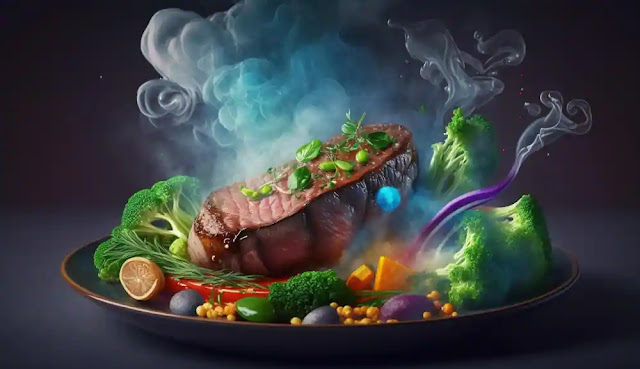Which meat is good Halal or Jhatka, for this first we have to understand difference between halal and jhatka.
Halal: The animal was slaughtered with multiple cuts on the neck area.
Let the heart pump all the blood through the cut made. The cut gradually deepens as the heart slows down.
Jhatka: Jhatka is a method of animal slaughter practiced in specially in Sikhism and other religions except Muslims.
In which an animal is killed instantly with a single blow.
This method does not involve drawing blood.
Jhatka meat is considered fit for consumption by Sikhs and other religion.
Which is Healthier Halal or Jhatka
Many answers to this question I have observed.
They argue that halal slaughter is less painful because it cuts off the carotid artery that pumps blood to the brain.
They do not understand the mechanism of pain. Pain is caused by any kind of trauma.
Trauma sight and pain centers in the brain are connected through the nervous system.
The spinal cord is the main route of this connection.
In a halal cut, the spinal cord is intact and that is why the movement is extremely jerky.
This jerky movement is caused by pain. In a jhatka cut, the spinal cord is cut immediately so no pain is felt.
This is why the jatka cut is a less painful way of slaughter than the halal cut. .
Which Meat is Good Halal or Jhatka
The difference lies between the two methods of slaughtering animals and is completely clear through scientific studies and literature.
Normally, any sensation felt in our body (somatic cells) is first sensed by the relevant receptor proteins and then transmitted by nerves through the spinal cord to the brain.
The brain response is again transmitted through nerve cells in the spinal cord and manifests through the affected muscles of the body.
In the case of halal slaughter, this spinal nerve pathway is intentionally left undisturbed, while in the case of jhatka it is interrupted immediately;
therefore, the pain sensation is sure to disappear immediately in jhatka method while in the case of halal the pain sensation is transmitted from the brain until the death of the animal.
One of the most accepted ways to measure pain is an electroencephalogram, or study of the electrical nerve response in the brain.
Docile animals such as cows and sheep do not always express their pain clearly; EEG study worked perfectly to find out their pain sensation.
Scientists have shown that within 5-10 seconds after cervical dislocation (which occurs during jhatka slaughter), the function of the cerebral cortex (brain) stops working.
Similar studies conducted by French researchers on abdominal incisions in the neck (made during halal slaughter) showed that cattle exhibit pain responses for up to 60 seconds and sometimes within Few minute.
And if the cut fails during the halal period, the animal will suffer unbearable pain.
The reason behind this distress is twofold, mainly because the nerve connection through the spinal cord is intact and secondly that the vertebral arteries that supply blood to the brain are not affected during the halal slaughter.
In contrast, in jhatka slaughter, nerve and blood vessel connections are interrupted immediately, so the brain is deprived of oxygen and as a result the animal, after being decapitated, is almost instantaneous, completely unconscious.
Neck incision made during halal slaughter causes ‘harmful irritation’ and contributes to a significant increase in pain sensation in slaughtered animals according to studies by Australian research groups and United Kingdom.
The pioneering work of the famous American scientist Temple Grandin showed that if slaughter is carried out without anesthesia, blood cortisol levels increase, leading to an increase in the animal’s muscle temperature.
Normally, a moderate level of adrenaline in response to stress converts muscle glycogen into lactic acid which lowers the pH of the meat (making the meat acidic) and this not only keeps the meat tender and pink. but also protects the growth of harmful bacteria.
But with a stress-slaughtering method like halal, the over-secretion of the same hormone quickly causes total muscle glycogen to be depleted;
therefore, by the time the meat is marketed, there is no lactic acid left, resulting in a higher pH, promoting bacterial growth with a drier, darker, and firmer quality of meat.
In addition, most stress hormones (with the exception of adrenaline) are steroid chemicals in nature and can therefore directly cross cell membranes to bind to nuclear receptors (DNA) causing changes in the cell membrane.
irreversible changes to the genome in the cell, the effects of this interaction can be long-lasting. even after the complete removal of blood from the body of the slaughtered animal.
Flawed concept: This halal is the only method of sucking blood so there is no impurity or disease.
Halal meat is considered pure by Muslims solely for the reason that Muslim prayers are read before and during the cutting and slaughter of animals and thus a common misconception has been deliberately propagated to appease a large (Muslim) carnivorous community that brought huge profits.
Much of the economic benefit to the $2.71 trillion meat industry (most countries in the world do not have such economies of scale).
Conclusion
Animals suffer a lot when performing halal and at this time, the adrenal glands and other hormones are released 40 times faster, the amount of which is harmful to human health.
By eating halal meat, our stomach starts to get ulcer, hence people start having stomach and liver problems.
In addition, eating halal meat increases cholesterol in the body, which is very harmful to the heart.
By eating halal meat, puberty starts early in children, so children start becoming adults at an early age.
So don’t blindly follow anything, always see the scientific side of any ritual.
Note – I am personally a vegetarian and do not support the slaughter of animals for food.
What is the survival rate of ventilator patients | ventilator survival rate
👇👇👇
Can a human survive with one kidney | Living with One Kidney






